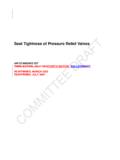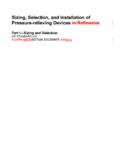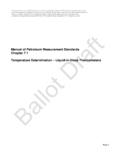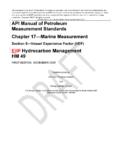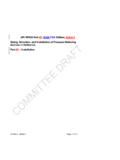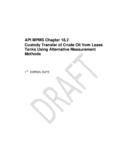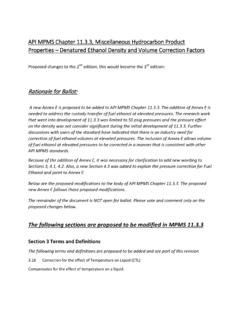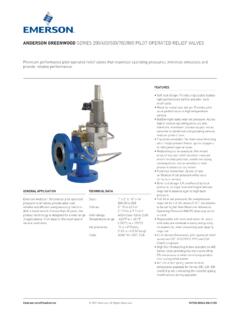Transcription of Inspection of Pressure elieving Devices - API
1 Inspection of Pressure Relieving Devices API RECOMMENDED PRACTICE 576 FOURTH EDITION, (MONTH), 20XX Inspection of Pressure Relieving Devices 1 Scope This recommended practice (RP) describes the Inspection and repair practices for self-actuated Pressure relieving Devices commonly used in the oil/gas and petrochemical industries. As a guide to the Inspection and repair of these Devices in the user s plant, it is intended to ensure their proper performance. This publication covers self-actuated Devices such as direct acting spring loaded valves , pilot operated Pressure - relief valves , rupture disks, pin actuated Devices and weight-loaded Pressure vacuum vents. The recommendations in this publication are not intended to supersede requirements established by regulatory bodies. This publication excludes tank weak seams and/or sections or tank thief hatches, explosion doors, fusible plugs, control valves , Pressure regulating Devices , integral rotating equipment components, other Devices that either depend on an external source of power for operation or are manually operated or Devices not designed to be inspected or recertified.
2 Inspections and tests made at manufacturers plants, which are usually covered by codes or purchase specifications, are not covered by this publication. This publication does not cover training requirements for personnel involved in the Inspection and repair of Pressure relieving Devices . Those seeking these requirements should see API 510/570, which gives the requirements for a quality control system and specifies that the repair organization maintain and document a training program ensuring that personnel are qualified. 2 Normative References The following referenced documents are indispensable for the application of this document. For dated references, only the edition cited applies. For undated references, the latest edition of the referenced document (including any amendments) applies. API 510, Pressure Vessel Inspection Code: In-service Inspection , Rating, Repair, and Alteration api standard 520 (All Parts), Sizing, Selection, and Installation of Pressure relieving Devices in Refineries api standard 521, Pressure relieving and Depressuring Systems api standard 526, Flanged Steel Pressure - relief valves api standard 527, Seat tightness of Pressure relief valves api standard 570, Piping Inspection Code.
3 In-service Inspection , Rating, Repair, and Alteration of Piping Systems, API Recommended Practice 580, Risk-Based Inspection api standard 653, Tank Inspection , Repair, Alteration, and ReconstructionAPI Standard 620, Design and Construction of Large, Welded, Low- Pressure Storage Tanks api standard 650, Welded Tanks for Oil Storage COMMITTEE DRAFT2 API RECOMMENDED PRACTICE 576 api standard 2000, Venting Atmospheric and Low- Pressure Storage Tanks (Nonrefrigerated and Refrigerated) ASME PTC 25 1, Pressure relief Devices ASME Section VIII, Div. 1, Boiler and Pressure Vessel Code NB-18 2, Pressure relief Device Certification 3 Terms and Definitions When used within this document, the following terms and definitions apply. accumulation The Pressure increase over the maximum allowable working Pressure of the vessel Pressure - relief device, expressed in Pressure units or as a percentage of maximum allowable working Pressure or design Pressure if an MAWP has not been established.
4 Maximum allowable accumulations are established by applicable codes for emergency, operating and fire contingencies. backpressure The Pressure that exists at the outlet of a Pressure - relief device as a result of the Pressure in the discharge system. Backpressure is the sum of the superimposed and built-up backpressures. blowdown The difference between the set Pressure and the closing Pressure of a Pressure - relief valve, expressed as a percentage of the set Pressure or in Pressure units. built-up backpressure The increase in Pressure at the outlet of a Pressure - relief device that develops as a result of flow after the Pressure - relief device opens. burst Pressure The value of the upstream static Pressure minus the value of the downstream static Pressure just prior to when the disk bursts. When the downstream Pressure is atmospheric, the burst Pressure is the upstream static gauge Pressure .
5 Burst Pressure tolerance The variation around the marked burst Pressure at the specified disk temperature in which a rupture disk will burst. car seal A device installed on a valve to secure it in a specified position (open or closed). When properly installed, the associated valve cannot be operated unless the car seal is physically removed. 1 ASME International, Three Park Avenue, New York, New York, 10016-5990, 2 The National Board of Boiler and Pressure Vessel Inspectors, 1055 Crupper Avenue, Columbus, Ohio 43229, COMMITTEE DRAFT Inspection OF Pressure RELIEVING Devices 3 closing Pressure The value of decreasing inlet static Pressure at which the valve disc reestablishes contact with the seat or at which lift becomes zero, as determined by seeing, feeling or hearing. cold differential test Pressure (CDTP) The Pressure at which a Pressure - relief valve is adjusted to open on the test stand.
6 The cold differential test Pressure includes corrections for the service conditions of superimposed backpressure or temperature or both. design Pressure The Pressure , together with the design temperature, used to determine the minimum permissible thickness or physical characteristic of each vessel component as determined by the vessel design rules. The design Pressure is selected by the user to provide a suitable margin above the most severe Pressure expected during normal operation at a coincident temperature. It is the Pressure specified on the purchase order. This Pressure may be used in place of the maximum allowable working Pressure (MAWP) in all cases where the MAWP has not been established. The design Pressure is equal to or less than the MAWP. galling A condition whereby excessive friction between high spots results in localized welding with subsequent splitting and a further roughening of rubbing surfaces of one or both of two mating parts.
7 Huddling chamber An annular chamber located downstream of the seat of a Pressure - relief valve for the purpose of assisting the valve to achieve lift. lift The actual travel of the disc away from the closed position when a Pressure - relief valve is relieving. lifting lever A device on the relief valve that applies external force to the stem of the relief valve which can be used to manually operate the valve. manufacturing design range The Pressure range at which the rupture disk shall be marked. Manufacturing design ranges are usually catalogued by the manufacturer as a percentage of the specified burst Pressure . Catalogued manufacturing ranges may be modified by agreement between the user and the manufacturer. marked burst Pressure The burst Pressure established by tests for the specified temperature and marked on the disk tag by the manufacturer.
8 The marked burst Pressure may be any Pressure within the manufacturing design range unless otherwise specified by the customer. The marked burst Pressure is applied to all of the rupture disks of the same lot. COMMITTEE DRAFT4 API RECOMMENDED PRACTICE 576 maximum allowable working Pressure (MAWP) The maximum gauge Pressure permissible at the top of a vessel in its operating position at the designated coincident temperature specified for that Pressure . The Pressure is the least of the values for the internal or external Pressure as determined by the vessel design rules for each element of the vessel using actual nominal thickness, exclusive of additional metal thickness allowed for corrosion and loadings other than Pressure . The MAWP is the basis for the Pressure setting of the Pressure - relief Devices that protect the vessel. The MAWP is normally greater than the design Pressure but can be equal to the design Pressure when the design rules are used only to calculate the minimum thickness for each element and calculations are not made to determine the value of the MAWP.
9 Non-reclosing Pressure - relief device A Pressure - relief device, which remains open after operation. A manual resetting means may be provided. opening Pressure The value of increasing inlet static Pressure whereby there is a measurable lift of the disc or at which discharge of the fluid becomes continuous, as determined by seeing, feeling or hearing. overpressure The Pressure increase over the set Pressure of the relieving device. Overpressure is expressed in Pressure units or as a percentage of set Pressure . Overpressure is the same as accumulation only when the relieving device is set to open at the maximum allowable working Pressure of the vessel. pop Pressure The value of increasing inlet static Pressure at which the disc moves in the opening direction at a faster rate as compared with corresponding movement at higher or lower pressures pin-actuated device A non-reclosing Pressure - relief device actuated by static Pressure and designed to function by buckling or breaking a pin which holds a piston or a plug in place.
10 Upon buckling or breaking of the pin, the piston or plug instantly moves to the full open position. qualified person A competent person who has met the knowledge, skill requirements and expectations of the owner-user. set Pressure The inlet gauge Pressure at which a Pressure - relief valve is set to open under service conditions. simmer The audible or visible escape of compressible fluid between the seat and disc, which may occur at an inlet static Pressure below the set Pressure prior to opening. COMMITTEE DRAFT Inspection OF Pressure RELIEVING Devices 5 specified burst Pressure The burst Pressure specified by the user. The marked burst Pressure may be greater than or less than the specified burst Pressure but shall be within the manufacturing design range. The user is cautioned to consider manufacturing design range, superimposed backpressure and specified temperature when determining a specified burst Pressure .
